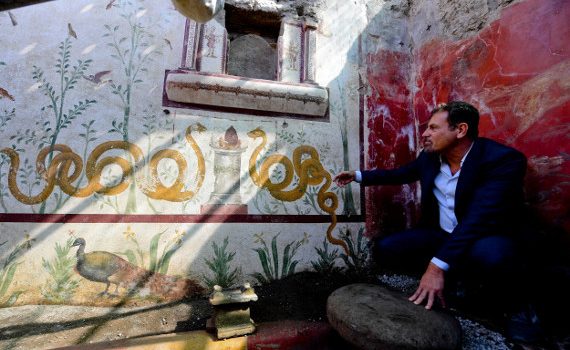A sumptuous lararium has re-emerged in a room which is still being excavated in Regio V at Pompeii
A sumptuous 4m x 5m lararium has re-emerged among the lapilli in a room which is still being excavated in Regio V at Pompeii, as part of the consolidation works on the excavation fronts overseen by the Great Pompeii Project.
The beautiful lararium, which is among the most elegant to be found at Pompeii, belongs to a room in a house which had already been partially excavated at the beginning of the twentieth century, and which is accessed from Vicolo di Lucrezio Frontone. At the centre of a wall featuring idyllic landscapes and lush natural scenes, including plants and birds, we find a sacred shrine with figures of the Lares - the protectors of the house - painted on the sides. Below, we see two large ‘agathodaemon’ serpents (good daemons), which symbolise prosperity and good luck. In a continuous game played between reality and illusion, painted plants blend and mix in the room with the real ones which must have thrived in the flowerbed under the lararium, while a painted peacock seems to tread the earth of the garden. Similarly, the painted altar with offerings (a pinecone and eggs) between the two serpents, is mirrored by a stone arula (small altar) found in the small garden, and upon which traces of burnt offerings can still be seen. These offerings were made to honour the domestic gods, in order to guarantee the wellbeing and prosperity of all the family. On the opposite wall, however, we see a hunting scene on a red background, with various light-coloured animals which surround a black boar, seeming to symbolically allude to the victory of the forces of good over those of evil.
This was a room used for worship, whose arrangement is still to be defined, given the unusual position of certain elements such as the basin bordered by a small garden, located at the centre of the room, and the mezzanine space which closes off one of the sides, and which is still entirely to be excavated.
“These extraordinary discoveries, which continue to evoke great emotion, form part of the larger maintenance operation to stabilise the excavation fronts - declares Director General Massimo Osanna - which is focusing on approximately 3 km of fronts which delimit the un-excavated area of Pompeii. It is a fundamental intervention in one of the most at-risk areas of the site, which has never before been treated as a whole and which today, thanks to the reprofiling operation of the fronts which seeks to reduce the pressure of the ground on already excavated areas, is also allowing us to bring intact rooms with splendid decorations to light.”
(Photo courtesy of Ciro Fusco)
Click here for the image gallery on Facebook
https://www.youtube.com/watch?v=mAjuJL4v6V8


